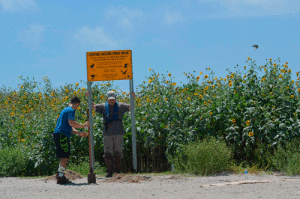
Installing signs at Chester Island Bird Sanctuary
It is summer time and Chester Island Bird Sanctuary, located near the Matagorda Ship Channel “big jetties”, is brimming over with Colonial Waterbirds. These are Herons, Egrets and other similar birds – who gather in large groups called rookeries or colonies during nesting season to build nests, lay eggs and raise their chicks. With continued coastal development, uninhabited places like Chester Island become even more valuable to these birds’ continued existence.
For many species like Brown Pelican and Royal Tern, the parents are now teaching their young how to fly around the beach area. Others, like the Black Skimmer, are still sitting on eggs very near the shoreline. All are vulnerable to human disturbance, which can cause birds to flee or abandon their nests – leaving eggs and chicks to overheat in the sun or become victims of predators and other birds.
Audubon Coastal Warden Tim Wilkinson and son Tyler recently posted several yellow signs along the shoreline to help remind fisherman and other boaters not to disturb nearby nesting birds. We ask for the public’s cooperation by staying at least 50 yards away from the shoreline and from nesting birds – and please no landing or walking on the island. Both at Chester Island and other locations around Matagorda Bay, if birds are flying around you and getting louder, that normally means nests and babies are very close and you are causing disturbance of the birds. This is serious business, as the birds of Chester Island are protected from human disturbance by both federal and state law – by both the U.S. Migratory Bird Treaty Act of 1918 and Parks And Wildlife code 64.002.(a)(1,2,3).
Chester Island (aka Sundown Island or Bird Island) is recognized by the National Audubon Society as a Globally Important Birding Area for the essential habitat it provides for breeding, wintering or stopovers of several threatened and vulnerable species. 2016 is turning out to be a great nesting season – with almost 20,000 nesting pair of 18 species utilizing every corner of this 65 acre island. So please help us continue to protect this valuable environmental resource!!
The island and birds are closely monitored by Warden Wilkinson and local volunteers. For questions or to become a volunteer, he can be reached by email at twsword@gmail.com. To donate, visit tx.audubon.org.
